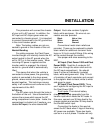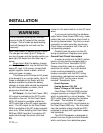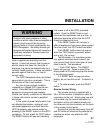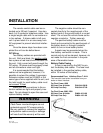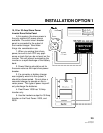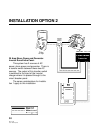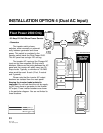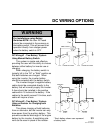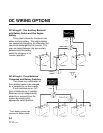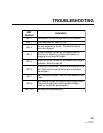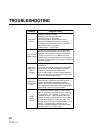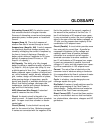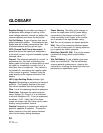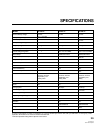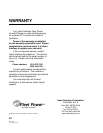
90-0115-00
10/97 Fltman.pm65
GLOSSARY
Alternating Current (AC) An electric current
that reverses direction at regular intervals.
Sources of alternating current are shore power,
generator power, inverter power or household
current.
Ampere (Amp, A) The unit of measure of
electron flow rate of current through a circuit.
Ampere-hour (Amp-Hr., AH) A unit of measure
for a battery's electrical storage capacity, ob-
tained by multiplying the current in amperes by
the time in hours of discharge (Example: a
battery which delivers 5 amperes for 20 hours
delivers 5 amperes times 20 hours, or 100
Amp-Hr. of capacity.)
AH Capacity The ability of a fully charged
battery to deliver a specified quantity of electric-
ity (Amp-Hr., AH) at a given rate (Amp, A) over
a definite period of time (Hr.). The capacity of a
battery depends upon a number of factors such
as: active material, weight, density, adhesion to
grid, number, design and dimensions of plates,
plate spacing design of separators, specific
gravity and quantity of available electrolyte, grid
alloys, final limiting voltage, discharge rate,
temperature, internal and external resistance,
age and life of the battery (bank).
AWG (American Wire Gauge) A standard
used to measure the size of wire.
Circuit An electric circuit is the path of an
electric current. A closed circuit has a complete
path. An open circuit has a broken or discon-
nected path.
Circuit (Series) A circuit which has only one
path for the current to flow. Batteries arranged
in series are connected with the negative of the
first to the positive of the second, negative of
the second to the positive of the third, etc. If
two 6 volt batteries of 50 ampere-hours capac-
ity are connected in series, the circuit voltage is
equal to the sum of the two battery voltages, or
12 volts, and the ampere-hour capacity of the
combination is 50 ampere-hours.
Circuit (Parallel) A circuit which provides more
than one path for current flow. A parallel ar-
rangement of batteries (of like voltage and
capacity) would have all positive terminals
connected to a conductor and all negative
terminals connected to another conductor. If
two 12 volt batteries of 50 ampere-hour capac-
ity each are connected in parallel, the circuit
voltage is 12 volts, and the ampere-hour capac-
ity of the combination is 100 ampere-hours.
Current The rate of flow of electricity or the
movement rate of electrons along a conductor.
It is comparable to the flow of a stream of water.
The unit of measure for current is ampere.
Cycle In a battery, one discharge plus one
recharge equals one cycle.
Dip Switch A series of small switches used for
special programming of the Fleet Power in-
verter/charger. These switches are located on
the back of the Fleet Power remote panel.
Direct Current (DC) Current that flows continu-
ously in one direction such as that from batter-
ies, photovoltaics, alternators, chargers and DC
generators.
37



